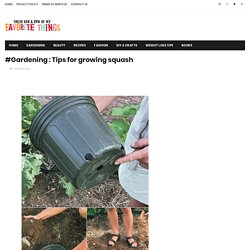

Amazing! 300 Different Varieties Of Squash From All Around The World...And Their Names! Skörda zucchini. När är det dags för zucchiniskörd och vad behöver man tänka på.

I detta inlägg berättar vi om hur vi tänker och gör när vi skördar. Många odlare drömmer om att få de mest fantastiska skördar. Man experimenterar med gödsel, jord, växthus och annat för att få så många frukter som möjligt och så stora frukter som det går. Den som odlar zucchini för första gången blir ofta väldigt nöjd. Med rätt förutsättningar blir en planta ganska snabbt enorm och när den väl börjat producera frukter är det superenkelt att få gigantiska frukter. I odlandet av zucchini gäller inte devisen: störst är bäst och godast. Så får man många frukter För att få många frukter ska man skörda ofta, då produceras nya blommor och därmed också frukter. Så här gör du eget gödselvatten på brännässlor och åkerfräken: br /> Zucchiniblommor är en delikatess Har man mycket frukter på gång och plantan fortsätter att blomma rikligt kan man lyxa till det med att skörda även blommorna.
Lagring Vi brukar inte frysa in zucchini. A Thanksgiving Winner: Roasted Acorn Squash with Maple Syrup, Butter, and Cayenne. Posted on: November 8, 2019 at 5:13 pm Fall is the best season when it comes to food.

There’s a reason why Thanksgiving dinner recipes are more iconic and beloved than any other holiday: they’re delicious, hearty, and include pie. Here’s a recipe that features a scrumptious fall food icon that takes only a few minutes to prepare. Types of Squashes. How to Grow Zucchini - The Fabulous Garden. #Gardening : Tips for growing squash - My Favorite Things. Tips for growing squash, Place the seeds AROUND the pot.

When you water, you water inthe pot so the water comes out of the drain holes around the bottom for deep root wateringHow to:To prepare a planting hill, dig a hole 2 feet deep and fill lit half full with compost. The plant roots will respond with vigor when they reach the compost.Place the pot in the center of the hole, with the lip extending above the ground 1 to 2 inches. Backfill the hole with the original soil.Prepare the seed bed by raking the soil smooth around the pot and tamping it down with a soil rake. Try to avoid getting any soil in the pot. Once the seeds have germinated, we thin each hill to the two or three strongest plants.
How To Grow Squash on a Garden Arch - Get Busy Gardening. I’ve been growing squash on my homemade squash arch for a few years now, and I love how it looks.

The squash arch makes a gorgeous addition to my vegetable garden, and I get tons of compliments on it. I’ve also shared my design with you so you can build your own squash arch, and many of you have! After planting the squash in the spring, we want the plants to quickly cover the garden arch, but the squash vines don’t always cooperate. Squash vines aren’t great climbers on their own – you have to train the squash to grow over the arch.
How To Grow Squash on a Garden Arch - Get Busy Gardening. Yokohama Squash. Imagine my surprise when I went into the garden this past August, and I found it littered with oddly shaped squash that resembled large chunks of hardened lava.

Gray-black, other-worldly, yet hauntingly beautiful, this unique heirloom vegetable from Japan, the ‘Yokohama’ squash, was a visual study in the Japanese affection for serenity through form and texture. Not only that, the ‘Yokohama’ possesses one of the most complex flavors I have run across in any squash or pumpkin I have grown.
Everyone’s taste buds are different, but I detect hints of Asian pear, mango, avocado, lemon balsam, and if you have experience with tropical fruits, the unmistakable aroma of sapote. §. The practice of companion planting has been around for generations.

We see the principle working brilliantly when the three sisters – corn, beans and squash – are planted together. Each crop is doing its part to sustain the other. Benefits of companion planting // Cuts out the need for chemicals// Reduces labor in the garden// Plants benefit each other by providing shade and attracting pollinators// Helps the plants work in harmony by building nutrients in the soil “Companion planting is about marrying plants that work well together in order to survive and grow strong and healthy. Companion planting techniques // Some plants are known as nature’s pesticides and deter pests. 3 Common summer crops and their companion plants Tomatoes love: // Beans supply nutrients to the soil around tomatoes.
Summer Squash. Growing Squash - Bonnie Plants. Summer squash are so productive that most gardeners need only a few plants to provide all they need.

Winter squash such as butternut are grown in summer for fall harvest and winter storage. These vines need plenty of room to grow. Growing squash is easier than you might think. Plant a buttery Yellow Crookneck, delicately flavored Golden Scallop Pattypan, and a Black Beauty zucchini, and by time peak season rolls around, you could be picking several squash a day — more than enough to eat, freeze, and gift to friends and neighbors. There is no hurry to harvest nutrient-rich “winter” squash like Acorn, Buttercup, and Butternut, which ripen to full maturity before they are picked. Soil, Planting, and Care.